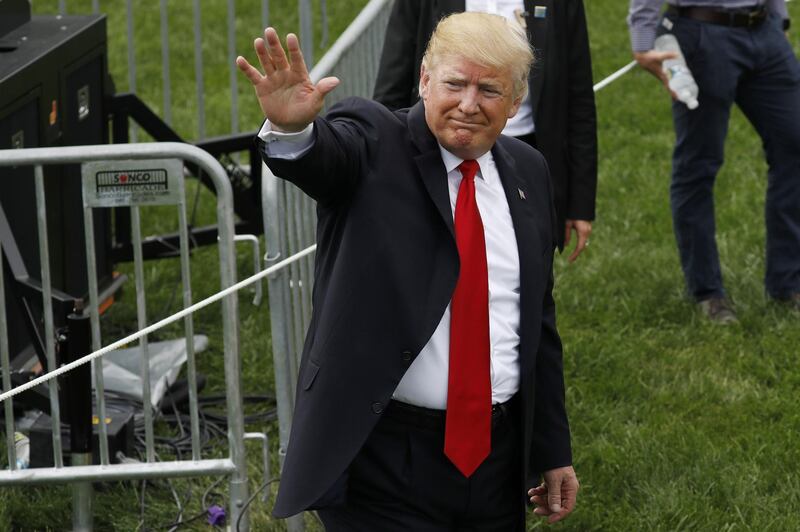Friday July 6 is the date when the world’s two largest economies are due to slide deeper into a trade conflict that’s roiled markets and cast a shadow over the global growth outlook.
In Beijing, policymakers are digging in for what could be a protracted fight - one they say they won’t be the aggressor in. If the US begins imposing additional steep tariffs on Chinese imports as of Friday, then Beijing is poised to respond in kind. With further tit-for-tat levies already threatened, this week could mark the start of a new and dangerous phase.
The US imposition of tariffs on $34 billion of China’s exports will not only hurt China, but the US itself and the rest of the world, Gao Feng, China’s Commerce Ministry spokesman, said in Beijing on Thursday. China’s retaliatory tariffs will become effective “immediately” after the US acts, according to the customs authority.
On June 15, President Donald Trump said the US would begin charging additional duties of 25 per cent on $50bn worth of Chinese imports in response to what he says is theft of American intellectual property. That’s split into two rounds - $34bn now and $16bn later.
China responded with a statement saying it would fight back with “equal scale, equal intensity”. Beijing is targeting soya beans, corn, wheat, rice, sorghum, beef, pork, poultry, fish, diary products, nuts and vegetables, and autos in its first round of counter measures.
The first wave on US tariffs on $34bn of Chinese exports will take effect on July 6, according to a statement from the US Trade Representative, which didn’t specify a time. China’s response of additional tariffs on US goods will become effective "immediately" thereafter. If the US tariffs come in at midnight Friday US time, that’s midday Friday in Beijing.
Chinese stocks have taken a beating in recent weeks, entering a bear market, as concerns about the trade-war have mingled with worries about how an ongoing debt-control campaign will feed through into the outlook for economic growth.
Stocks fluctuated Thursday, as investors may be waiting to see which way the tariffs are actually implemented.
_______________
Read more:
Trade war effects will only take shape in August
US drafting curbs on China's investment in US technology sector
_______________
"Any market rebound before the July 6 deadline would be just temporary. All eyes are on the Trump administration’s move to impose the 25 per cent additional tariff on Friday and what’s next after that," said Zhang Gang, Central China Securities Holdings strategist in Shanghai. "The trade war is a constant overhang for the markets and I don’t see it being removed any time soon."
The yuan slipped Thursday despite the strongest daily reference rate since October. China’s currency suffered its worst quarter since 1994 in the three months through June, raising questions over whether the government was deliberately letting it slide as a tactic in the trade war.
The tariffs are already having an effect. As an example, Chinese companies are reselling US soya beans, and Chinese companies are expected to cancel most of the remaining soya beans they have committed to buy from the U. in the year ending August 31, once the extra tariffs take effect.
In China, what will the economic impact be?
It depends on what happens. In the scenario where the US and China just stick to this round of tariffs - $50bn of imports -- and go no further, then the drag on China’s economy would be 0.2 percentage point of growth in 2019, according to Bloomberg Economics’ calculations.
If things escalate, then the hit will be bigger, cutting as much as half a percentage point from growth. China’s economy grew by 6.9 per cent in 2017 and the government has set a target of 6.5 per cent for the current year.
Domestically, it’s China’s rich coastal provinces who have the biggest reliance on exports. Guangdong, Shanghai, Zhejiang, Jiangsu and Fujian all have export-to-GDP ratios higher than the national average of 18.5 per cent, according to Bloomberg Economics. In the meantime, those provinces have lower debt-to-GDP ratios, stronger growth and more dynamic private sectors, which can help cushion the blow.
“The tail risk of a Sino-US trade war is getting fatter,” said Chi Lo, greater China senior economist at BNP Paribas Asset Management in Hong Kong. “The two sides may misjudge each other’s intentions when patriotism takes over rationality, and push themselves into an escalating series of attacks and retaliation.”






